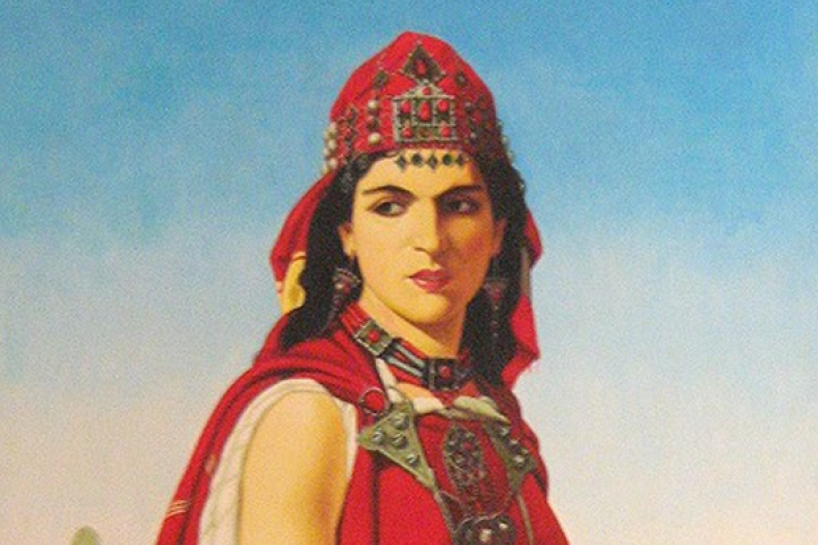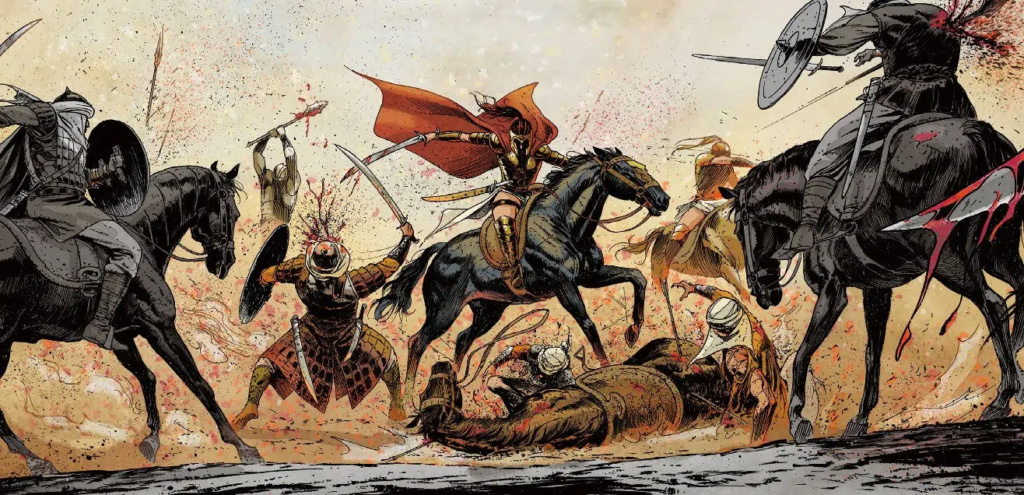!Queen Dihya... the woman whom the Arab "invasions" found no other way but to kill her

No, Dihya was not only a queen, but also a military leader who succeeded King Axel and ruled over the Amazighs and North Africa. I engraved the name of the Amazigh woman with the groans of swords and her veins, against history, in the record of success and perpetuation. It also extracted the consensus of the narrators that... she was one of the most powerful women throughout the ages.
The Arabs call me the priestess, that is, the witch. They know that I speak to you and that you listen to me. For them, the most beautiful girl is nothing but a commodity, with no right to speak or to be heard. A free woman scares them, and in their eyes I am the devil.”
… These were the words of the Algerian writer Kateb Yassine, in the words of Queen Dehya. It appeared in his novel “Najma” published in 1956.
Dihya's personality was subject to many ideological tensions, as the Arabs demonized her and portrayed her as a witch who uses the jinn in her wars. And it fought Islam and Muslims. Some Amazighs also ideologized and mythologized this character, in addition to the huge exaggerations with which they surrounded this common Amazigh and human “symbol.”
No, Dihya was not only a queen, but also a military leader who succeeded King Axel and ruled over the Amazighs and North Africa. I engraved the name of the Amazigh woman with the groans of swords and her veins, against history, in the record of success and perpetuation. It also extracted the consensus of the narrators that... she was one of the most powerful women throughout the ages.
Dihya, or Tehya or Deya, saw the light in 585 AD. At the time I was born, there were no borders in North Africa. Rather, the region was a handful of tribes, such as the Sanhaja, Zanata, and Masmouda, that had one common denominator: Amazigh. “Tribes did not know calm or stability except in a few periods. Therefore, their continuous movement extended until the Arabs entered North Africa, and for this reason they were also warrior tribes by nature,” according to what was stated in a report by the TRT Arabic newspaper on Dehya.

According to the report, there are no historical sources that convey accurate pictures of Dihya’s childhood, but a number of researchers in Amazigh history and culture have concluded that all that was found … is that “the priestess received special training for the children of leaders and leaders. A military and cultural formation, which qualified her to inherit the rule of “Jarawa” from her father later.
There were conflicting opinions regarding her religion, as there were those who considered her Jewish, and there were those who said that she was pagan, under the pretext that the Jewish religion, at that time, was confined to Jewish merchants in Roman cities, and also due to the cordon and siege imposed on the movements and temples of the Jews.
She succeeded King Kusayla in the rule of the Amazighs in North Africa in the year 680 AD, that is, when she was 95 years old. And its capital remained throughout its rule, the city of Khenchela in the Aures Mountains, in present-day Algeria.
It was stated in the accounts of historians that the Amazigh tribes unanimously agreed to take over “Dehya” as their ruler, the day after death snatched their king, “axel”. As the ancient Amazigh traditions required that the tribal council vote upon the death of the ruler to choose a new ruler.
Ibn Khaldun says in the book “The Lessons and the Divan of the Beginner and the News in the Akhbar of the Arabs, the Persians and the Amazighs”: “Ifriqiya was ignited by a fire, and the matter of the Amazighs parted, and their authority was multiplied in their chiefs.
Her skill, strength, charisma and courage enabled her to unite the Amazigh tribes under her umbrella to confront the Romans and, after them, the Muslim Arabs.

According to some historical references, Queen Dehya led several campaigns and battles against the Romans, Arabs and Byzantines, in order to regain the Amazigh lands that they seized in the late sixth century AD.
The interesting thing is that Dehya’s rule coincided with the rule of Caliph Abd al-Malik Ibn Marwan, who wanted to resume the plan of Islamic “conquests” and Arab invasions , to subjugate more non-Muslim peoples.
Hassan bin al-Numan was chosen to lead Fatah in North Africa. After he managed to “invade” the city of Kairouan and “occupy” it, and expel the remnants of the Byzantines from Carthage, he tried to move to the tribes that are under the rule of Queen Dihia, nicknamed the priestess!
When Dihya heard the news of Hassan's army advancing towards her, she hurried to liberate the city of Khenchela from the Roman occupation, expelled the Romans from it, and then demolished its forts so that Hassan's army would not take refuge in them.
In the year 693 AD, Dihya faced the army of Ibn al-Nu`man in the battle of Bejaia, and was able to defeat it, forcing it to leave Tunis and Tripolitania, to settle in Cyrenaica, Libya, awaiting support from the Umayyad caliph.
Nevertheless, Queen Dehya did not seek to destroy the lands of the Muslims, did not touch Kairouan badly, did not kill the Muslims who were there, nor did she abuse them in revenge for what the Arabs “plotted” against her land!

After that, Dihya took control of North Africa for about five years, and there are accounts indicating that her kingdom forms, today, part of Algeria, Tunisia, Morocco and Libya.
It was distinguished by its humane sense and civilized behavior, which, according to historians, was the release of all eighty prisoners, without torturing them. However, she decided to keep one Arab captive, and it was Khalid bin Yazid Al-Qaisi, whom she adopted and lived with her and lived with her other children, and whom some narrations accuse of being the one who provided the Umayyads with intelligence information about the priestess.
Dehya a pu contrecarrer la «invasion» islamique, ou plutôt la repousser. Au bout de cinq ans, elle était sûre que l'avancée arabe revenait, puis elle s'est rendu compte qu'elle ne serait pas en mesure de l'arrêter comme avant, alors elle a eu recours à la politique de la «terre brûlée».
La "terre brûlée" était une stratégie pour détruire toutes les villes et tous les villages, car elle croyait que les "invasions" avaient pour objectif de "vider" les richesses de l'Afrique du Nord et de "voler" ses richesses.
Dehya n'acceptait pas l'idée que les «invasions» avaient pour but de répandre la religion islamique dans tous les pays, et c'est pourquoi on lui attribua le dicton: «Si vous prétendez que vous êtes venu avec un message de Dieu, alors donnez-le à nous et partons.
Dehia a ordonné d'abattre des arbres, de démolir des forts et de brûler des récoltes de Tripoli à Tanger, ce qui a suscité la colère des Africains, qui ont commencé à croire que la reine était devenue folle, alors ils se sont dispersés autour d'elle et beaucoup ont émigré en Andalousie.
Cette politique a également entraîné la fragmentation des amazighs, ce qui a conduit par conséquent à l'affaiblissement de Dehia, et par conséquent à sa défaite dans la deuxième bataille contre Hassan ibn al-Nu`man.
Dehya was able to thwart the Islamic “conquest”, or rather to postpone it. After five years, she was sure that the Arab advance was coming again, and then she realized that she would not be able to stop it as before, so she resorted to the “scorched earth” policy.

The “scorched earth” was a strategy to destroy all cities and villages, because it believed that the “conquests” had the goal of “draining” the wealth of North Africa and “robbery” of its bounties.
Dehya did not accept the idea that the “conquests” had the goal of spreading the Islamic religion in all countries, and therefore the saying was attributed to her: “If you claim that you have come with a message from God, then give it to us and leave.”
Dehia ordered to cut down trees, demolish forts, and burn crops from Tripoli to Tangiers, which aroused the ire of Africans, who began to believe that the queen had gone mad, so they dispersed around her, and many emigrated to Andalusia.
This policy also resulted in the fragmentation of the amazighs, which consequently led to the weakening of Dehia, and consequently to its defeat in the second battle against Hassan ibn al-Nu`man.
Researcher Nidar Al-Andalusi commented on this, saying: “If we can describe the warlike path of the priestess in her struggle with the conquerors, then we say that she is a queen and at the same time plans battles, implements her strategy, and assumes military leadership. It seems that she defended her homeland with iron and fire until the last breath, and imposed her rule by force that made her enjoy prestige, and she ended up burning all the natural resources that were coveted by the Arabs, but her killing constituted an ignominious defeat for her followers, so whoever was killed was killed and whoever escaped fled.
Dihya was killed in the battle of “Bir al-Kahina” in the year 82 AH corresponding to 701 AD, after she bravely fought the battle against the Islamic armies, rejecting calls to flee and hide behind rugged terrain.

?So how was Dihya killed
... her head was cut off and sent to the East. This extravagant representation of her corpse was a desire to avenge the voice of a woman who said no and made the “conquerors” taste the bitterness of defeat. It is also a strong indication of the various forms of resistance that could surface in the future!
“The wars that women fought throughout history were not for the sake of colonialism, but for the sake of resistance, and it is obvious that the war was not fought for the sake of war, but rather for the sake of defending its land,” Ahmed Asaid says in a documentary about the priestess.
He added that Queen Dihya also symbolizes love and tenderness, and her story is very inspiring, touching, and rich in drama… “Her image is the image of women in the ancient Amazigh society.”
In gratitude for what this woman presented to history, struggle, and death for the sake of the land and the homeland, the Aures El Kahina Association installed a 1.80-centimetre-tall statue of their national heroine in the center of the municipality of Baghay, Algeria, in 2003.
And in Morocco, starting from the first week of March 2021, a huge mural of the Amazigh Queen “Dihya” decorated the streets of Ait Ourir.
Written by: Ali bin Harar
Source : websites

